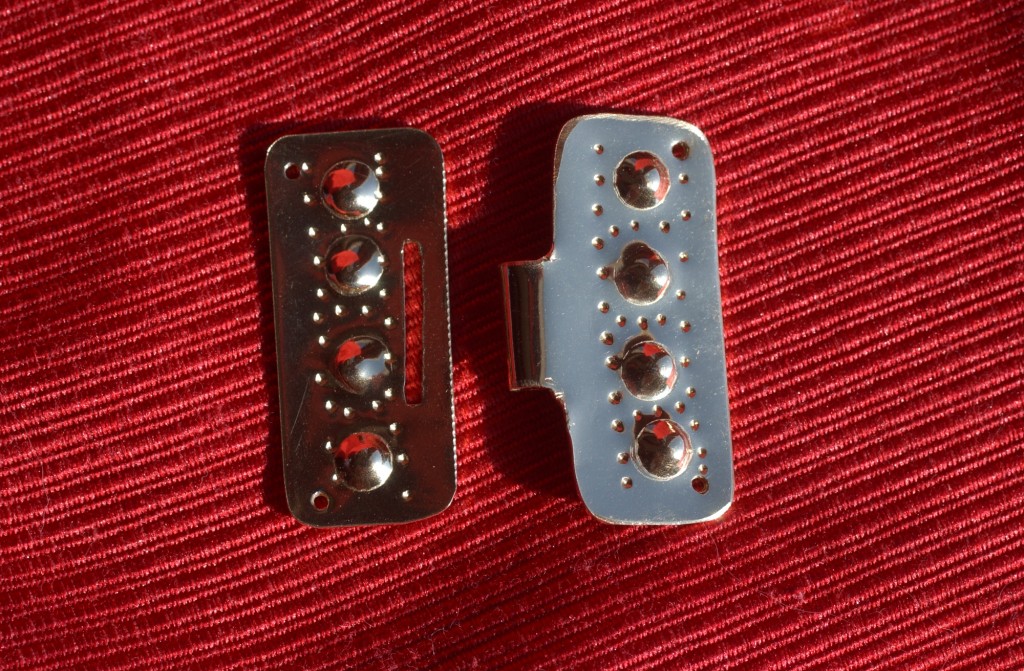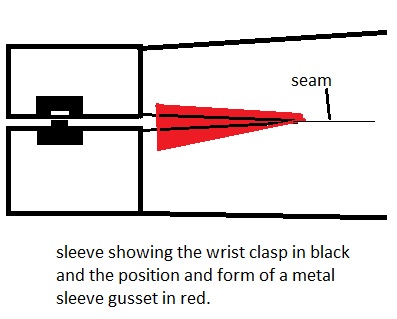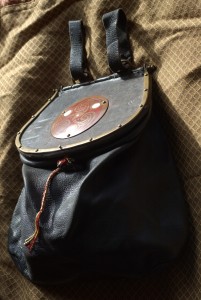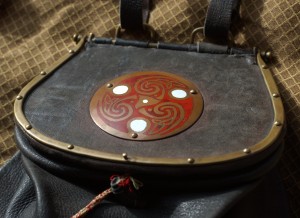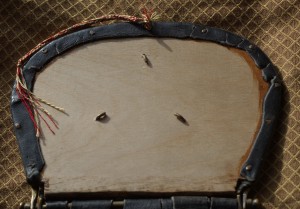What are Wrist Clasps, how are they used, and who used them?
First of all – what is a wrist clasp?
This is an example of a formed metal sheet wrist clasp set.
The mechanism of a wrist clasp is a metal hook and eye closure. The closure is used to close the wrist opening on a tunic. Now wrist clasps are not all literally hook and eyes in appearance, but that is how they function – there are two pieces to each clasp, a hook plate and an eye plate. The Wrist Clasp sets can be cast, formed sheet metal, or formed wire.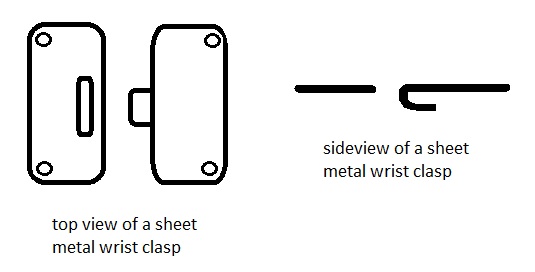
When I first began investigating Wrist Clasps I read an article online about how reenactors hated to wear Wrist Clasps because they were hard to use and they didn’t stay closed. Well, I thought about that for a while and decided that there was probably a good chance that someone was doing something wrong with the way the clasps were being used. Now first let me say that I am probably much older than most of my readers. I remember when wearing stockings meant wearing a garter belt, not because you were trying to be sexy, but because that was what there was – panty hose had not been invented yet. So, I have the concept of things being a bit fussy, particularly things associated with women’s clothing and even more specifically dressy women’s clothing. But if a thing is going to be used, it must be functional. It may require some occasional adjustments, but it must be functional.
Now, one of the problems that we have as reenactors is knowing what people wore on an everyday basis, verses what they were buried in. I never knew that my grandfather had a suit until I was at his funeral. He was buried in a suit, but never in my 14 years of knowing him had I ever seen him wear a suit. Did Vikings and Anglo Saxons wear wrist clasps in everyday life, or just for “fancy wear”? Well, in all honesty we really can’t be sure. If we assume that most folks did not have a large selection of clothing and wrist clasps were considered to be a regular part of a decently dressed individual’s clothing, then the wrist clasps had to function. So what were the reenactors doing wrong?
I made a copy of a basic sheet metal wrist clasp, and I played with it. And it worked. It worked just fine. I have a tunic with wrist clasps on the cuffs. They are a little hard to close, but they usually stay closed all day, without any adjustments. They are not uncomfortable. I had someone explain to me that Wrist Clasps were uncomfortable because the metal dug into their wrists when they leaned on a table. How much time did Vikings and Anglo Saxons spend leaning on a table? I don’t spend much time at all leaning on a table. I designed my sleeves to open along the outside edge of my wrist, so that the wrist clasps would show when my arms hung down straight. I made the sleeves fairly tight at the wrist, so that closing the clasps was a bit difficult, and the tightness of the sleeve held the hook of the Wrist clasps firmly in the “eye” of the receiver plate. They worked. They worked just fine.
From a historical standpoint, Wrist Clasps are considered to be an important piece of dress accessories for both Vikings and Anglo Saxons. Wrist clasps appear to have originated in Scandinavia. They were brought to Great Britain in about 475AD, probably by Norwegian Vikings. While commonly called “Wrist Clasps”, some people think that Viking men in Scandinavia used them as both wrist and ankle closures. I have not seen definitive proof of this. Women wore clasps at the wrist and the bosom, and also occasionally appear to have used clasps to close pouches. Traditionally it was believed that once the Vikings arrived in Great Britain, only the women continued to wear the clasps. One of the problems with this conclusion is that recent DNA research shows that the majority of Viking men who settled in Great Britain took local wives, who would have been Anglo Saxon. Anglo Saxon woman wore wrist clasps.
Among Anglo-Saxons the wrist clasps were often used in combination with tablet woven bands on cuffs and in some areas (Lincolnshire) leather bands replaced the tablet weaving. In the East Anglia and Cambridgeshire regions an additional triangular piece of metal, known as a “gusset plate” was used to cover the slit area of the sleeve opening.
Another interesting difference between Viking and Anglo-Saxon use of the wrist clasp was the method by which the clasps were attached. The Anglo-Saxon women sewed their clasps on, while in Scandinavia the clasps were frequently riveted to the clothing.
Vikings and Anglo-Saxons have three types of Clasps in common:
- Basic Hook and Eye Form
- Cast geometric or zoomorphic form
- Formed Metal sheet rectangular clasps
Here is an example of a simple cast Anglo Saxon Wrist Clasp Set

